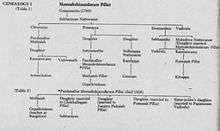Thanjavur Quartet
Thanjavur Quartet or Tanjore Quartet (Tamil: தஞ்சை நால்வர்) were four brothers: Chinnaiah, Ponniah, Sivanandam and Vadivelu, who lived during the early 19th century and contributed to the development of Bharatanatyam and Carnatic music.

They excelled in the art of Bharatanatyam.The brothers were employed in the courts of the Maratha King Serfoji II at Thanjavur.
Musical training
At the encouragement of the King they learnt the nuances of Carnatic music from a number of exponents of their time including Muthuswami Dikshitar. Dikshitar appreciated Vadivelu Pillai as an ekasandhagrahi, one who had the ability to repeat a song heard only once. The quartet wrote a set of nine songs called navaratna mela in tribute of their teacher.
After a stint at the courts of Serfoji, the brothers moved to Travancore and were patronised by Swati Tirunal. The king appointed Vadivelu Pillai as the court musician. Vadivelu Pillai also learnt to play the violin gained expertise and demonstrated that not only Kalpita sangeetam but Manodharma sangeetam could also be easily and deftly played on the instrument. After the Baluswami Dikshitar brother of Muthuswami Dikshitar have learnt violin from European missionary and introduced it in Carnatic music. Vadivelu also introduced the concept of Mohiniaattam. Until then Kathakali was the prevalent dance form in Kerala and was confined to male dancers. Vadivelu elaborated and refined Mohiniattam along with Maharaja Swathi Tirunal, and this paved the way for female dancers in Kerala.
Compositions
The four brothers composed numerous varnams and kritis. Some of these are Amba Souramba and Amba Neelamba, Ambaneelambari (Neelambari), Satileni (Poorvikalyani), apart from the navaratna mala.
See also
References
- Carnatica.net
- Arul Francis: Tanjore Quartet
- Tanjore Quartet Compositions
- Brihadisha - Tanjore Quartet
- The Musical Genius of Tanjavur Quartet
- Heritage Town